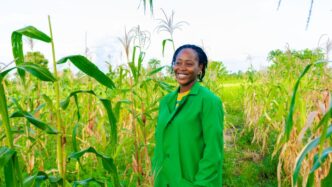Members of the Uganda Science Journalists Association (USJA)’s upcountry networks last weekend had the opportunity to train in biotechnology reporting and to see for the first time a genetically modified (GM) crop – maize that has managed to stand up against the devastating force of pests.
“I didn’t see any physical difference apart from the maize plant looking much healthier than the non-GM maize that was planted alongside it,” said Irene Abalo, Chairperson of the Northern Uganda Science Journalists Network (NUSJOURN).
“I think scientist need to come out boldly and defend their work instead of leaving it to politicians or activists to disseminate the information about their work. Such people might have vested interests contrary to food security or saving the world from hunger,” she added.
The two-day training, facilitated by the National Crops Resources Research Institute (NaCRRI) and the Cornell Alliance for Science took place in Namulonge, the home of NaCRRI, about 30km north east of Kampala.
USJA in 2016, supported by Internews, launched three regional science journalists’ networks to promote the understanding of key issues in science to all Ugandans through science journalism and science communication. These networks include the Eastern Uganda Science Journalists Network (EUSJOURN), the NUSJOURN and the Western Uganda Science Journalists Network (WUSJOURN). Three journalists were selected for the Namulonge trip from each of the networks to join a few others from the central region.
Genetically modified crops have been developed using modern scientific tools to among others tolerate drought and resist pests and diseases – some of the key factors negatively affecting Uganda’s and Africa’s agricultural productivity. Although there is scientific consensus that genetically modified crops are safe, Uganda is yet to release for farming and consumption the GM crops it has trialled successfully including bananas, cassava, maize and “irish”potatoes.
Ugandan scientists have condemned the political ping-pong surrounding the development of an enabling law that is needed for the release of the GM crops from confined fields behind the gates of research institutions.
Parliament in December 2017 passed the Biotechnology and Biosafety Bill 2012 into the Biosafety Act 2017 but President Yoweri Museveni is yet to assent to it. He subsequently returned the bill to Parliament seeking clarification on some issues including the title of the law, which clarification has reportedly been done.
Dr. Godfrey Asea, the Director of NaCRRI and also the Uganda country coordinator of the Water Efficient Maize for Africa (WEMA) project – under which these GM varieties are being developed – said that if the legal obstacles were removed, his team would be able to give farmers maize varieties tolerant to drought as well as resistant to stem borers and the fall armyworm within a year or two. WEMA is active in five African countries including Uganda, Kenya, Tanzania, Mozambique and South Africa, coordinated by the African Agricultural Technology Foundation (AATF).
Dr. Asea observed that “NaCRRI treasures the partnership with the media” before guiding the journalists through a tour of a field where the GM crop has shown tremendous success against maize stem borer and the fall armyworm with efficiency of 100% and 70% respectively – this is in addition to the maize being drought tolerant. Stem borer can destroy a garden by up to 80% while fall armyworm can wipe out an entire garden.


